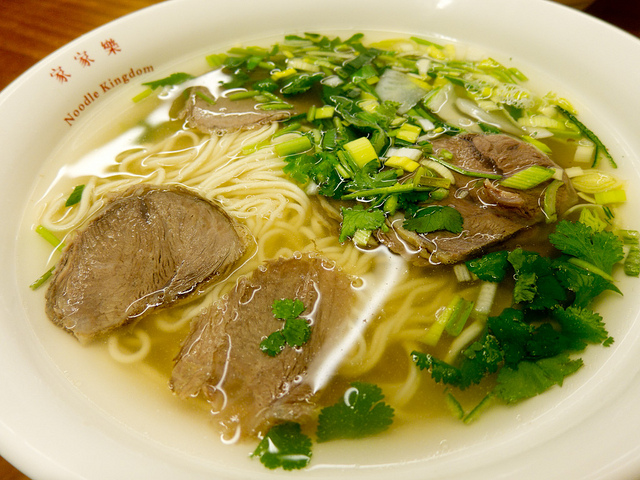Lanzhou Lamian Posted by sasha on Apr 9, 2018 in Culture
While the cuisine of China is incredibly diverse, there are some dishes that are ubiquitous all throughout the massive country. One such dish is lamian (拉面 – lā miàn) – literally meaning “pulled noodles.” The most famous place for lamian is the city of Lanzhou (兰州 – lán zhōu), capital of Gansu province. No matter where you are in country, you’re never too far from a piping hot bowl of these yummy noodles. In fact, it’s estimated that there are around 20,000 Lanzhou lamian restaurants in China! As the Golden Arches are to the US, Lanzhou lamian is to China. We’ll take a closer look at Lanzhou lamian and see how it’s made in this post that’s sure to leave your mouth watering.
An Intro to Lamian
Lanzhou lamian is made by taking a large lump of dough and repeatedly stretching and folding it. This serves a few purposes, as it both aligns the glutens and loosens it up. After this, the dough is pulled several times (hence the name) by an expert. It really is a work of art! The pulling continues until the desired thickness is achieved. When eating lamian across China, you’ll find that some places make very thick noodles while others go very thin. There’s no right or wrong way to make a bowl of lamian!
Watch an expert at work making the noodles.
There are 5 defining characteristics of a good bowl of Lanzhou lamian, which are easy to remember thanks to this fun Chinese phrase:
一清, 二白, 三红, 四绿, 五黄
yī qīng, èr bái, sān hóng, sì lǜ, wǔ huáng
1 clear, 2 white, 3 red, 4 green, 5 yellow
This is in reference to the clear soup, white radish, red chili oil, green coriander, and yellow for garlic and the noodles. Mix these all together and you have the perfect bowl of lamian.
Learn about lamian and practice your listening/reading skills in this video.
As most Lanzhou lamian restaurants are owned and operated by Hui people (回族 – huí zú), this famous noodle dish is typically halal. It’s most commonly made with beef, although mutton is sometimes used instead.
A Personal Story
Back when I lived in Beijing, there was a Lanzhou lamian restaurant half a block away from my apartment in Wudaokou. It’s actual name is Old Horse Lanzhou Pulled Beef Noodles (老马兰州牛肉拉面 – lǎo mǎ lán zhōu niú ròu lā miàn), but we always referred to it as “Meat Table.” This clever name came from two factors: 1. We couldn’t understand the Chinese characters in the actual name, and 2. They dumped bags of lamb on the table to make the delicious lamb kebabs (羊肉串儿 – yáng ròu chuàn er). Giving local restaurants silly English names became a favorite pastime of ours, and this was where it all began.
In my one year of living in the Wu, I must have eaten there nearly 100 times. Those big, hearty bowls of lamian got me through the painful Beijing winter, and at just 6-7 RMB a bowl left me plenty of money to go out and party at night. The staff of young Hui boys knew us all so well by the end of that year – especially our penchant for clearing out their supply of lukewarm Yanjing beer. When I think of my time in Beijing, this restaurant is one of the first things that comes to mind. I often find myself dreaming of being able to teleport to Meat Table for a quick bowl of lamian and a brew with old friends. If you ever travel to Beijing, be sure to find it and enjoy one of the best meals you’ll ever have.
How to Make Lamian
There’s no substitute for the real thing, so your best bet for eating an authentic bowl of lamian is traveling to Lanzhou. However, if you’d like to try your hand at making some classic lamian in your own kitchen, you can follow this great recipe from Woks of Life. You can also follow this video if you’re more of a visual learner:

Build vocabulary, practice pronunciation, and more with Transparent Language Online. Available anytime, anywhere, on any device.






Comments:
Hesh Lee:
You truly make me miss lamian with my mouth watering